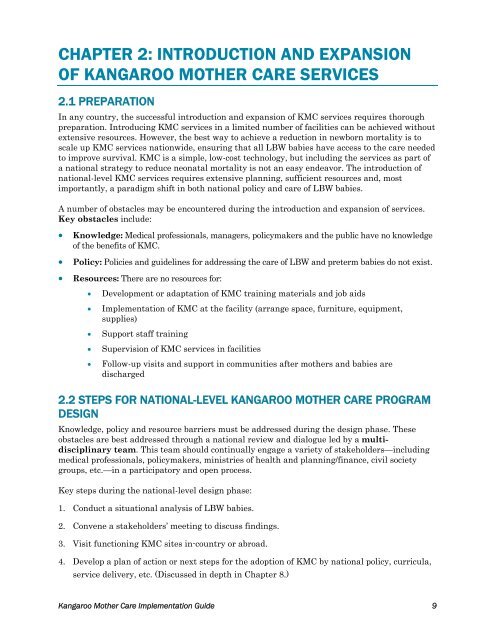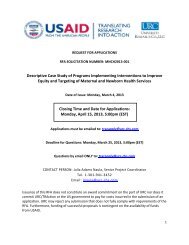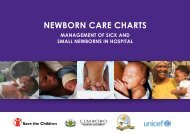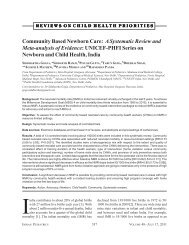Kangaroo Mother Care - MCHIP
Kangaroo Mother Care - MCHIP
Kangaroo Mother Care - MCHIP
Create successful ePaper yourself
Turn your PDF publications into a flip-book with our unique Google optimized e-Paper software.
CHAPTER 2: INTRODUCTION AND EXPANSION<br />
OF KANGAROO MOTHER CARE SERVICES<br />
2.1 PREPARATION<br />
In any country, the successful introduction and expansion of KMC services requires thorough<br />
preparation. Introducing KMC services in a limited number of facilities can be achieved without<br />
extensive resources. However, the best way to achieve a reduction in newborn mortality is to<br />
scale up KMC services nationwide, ensuring that all LBW babies have access to the care needed<br />
to improve survival. KMC is a simple, low-cost technology, but including the services as part of<br />
a national strategy to reduce neonatal mortality is not an easy endeavor. The introduction of<br />
national-level KMC services requires extensive planning, sufficient resources and, most<br />
importantly, a paradigm shift in both national policy and care of LBW babies.<br />
A number of obstacles may be encountered during the introduction and expansion of services.<br />
Key obstacles include:<br />
<br />
<br />
<br />
Knowledge: Medical professionals, managers, policymakers and the public have no knowledge<br />
of the benefits of KMC.<br />
Policy: Policies and guidelines for addressing the care of LBW and preterm babies do not exist.<br />
Resources: There are no resources for:<br />
<br />
<br />
<br />
<br />
<br />
Development or adaptation of KMC training materials and job aids<br />
Implementation of KMC at the facility (arrange space, furniture, equipment,<br />
supplies)<br />
Support staff training<br />
Supervision of KMC services in facilities<br />
Follow-up visits and support in communities after mothers and babies are<br />
discharged<br />
2.2 STEPS FOR NATIONAL-LEVEL KANGAROO MOTHER CARE PROGRAM<br />
DESIGN<br />
Knowledge, policy and resource barriers must be addressed during the design phase. These<br />
obstacles are best addressed through a national review and dialogue led by a multidisciplinary<br />
team. This team should continually engage a variety of stakeholders—including<br />
medical professionals, policymakers, ministries of health and planning/finance, civil society<br />
groups, etc.—in a participatory and open process.<br />
Key steps during the national-level design phase:<br />
1. Conduct a situational analysis of LBW babies.<br />
2. Convene a stakeholders’ meeting to discuss findings.<br />
3. Visit functioning KMC sites in-country or abroad.<br />
4. Develop a plan of action or next steps for the adoption of KMC by national policy, curricula,<br />
service delivery, etc. (Discussed in depth in Chapter 8.)<br />
<strong>Kangaroo</strong> <strong>Mother</strong> <strong>Care</strong> Implementation Guide 9
















